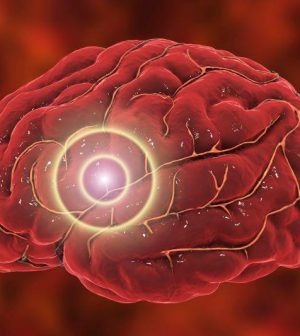- Skip Storing This Everyday Product in the Fridge Door
- Green Tea + B3 Pairing May Boost Brain Health
- Navigating Your Midlife Crisis: Embracing New Possibilities
- City Raccoons Showing Signs of Domestication
- Mapping the Exposome: Science Broadens Focus to Environmental Disease Triggers
- One Week Less on Social Media Linked to Better Mental Health
- Your Brain Changes in Stages as You Age, Study Finds
- Some Suicide Victims Show No Typical Warning Signs, Study Finds
- ByHeart Formula Faces Lawsuits After Babies Sickened With Botulism
- Switch to Vegan Diet Could Cut Your Greenhouse Gas Emissions in Half
Scientists May Have Solved Mystery of How Shock Therapy Works

It’s been around for a century, and electroconvulsive therapy — formerly known as electroshock therapy — has helped countless people with psychiatric conditions feel better.
But even the physicians who’ve used it have had little clue as to how it works.
Now, a team the University of California, San Diego (UCSD) believe they’ve unraveled that mystery.
“We’re solving a puzzle that’s stumped scientists and doctors since electroconvulsive therapy [ECT] was first developed nearly a century ago,” said study first author Sydney Smith, a PhD candidate in the Voytek Lab at UCSD. “On top of that, we’re also helping to demystify one of the most effective, yet stigmatized, treatments for severe depression.”
After decades of harrowing depictions in TV shows and movies, the treatment probably does need to improve its image.
“A lot of people are surprised to learn that we still use electroconvulsive therapy, but the modern procedure uses highly controlled dosages of electricity and is done under anesthesia,” Smith said in a university news release. “It really doesn’t look like what you see in movies or television.”
And ECT has a remarkable success rate: It’s effective in easing serious mental health issues such as bipolar disorder, schizophrenia and severe depression up to 80% of the time, the team said.
There are some downsides: ECT requires multiple outpatient visits, and post-treatment side effects can include transient confusion and issues with cognition, Smith’s team noted.
“One of the reasons ECT isn’t more popular is that for a lot of people, it’s easier and more convenient to just take a pill,” added study senior author Bradley Voytek, a professor of cognitive science at UCSD. “However, in people for whom medications don’t work, electroconvulsive therapy can be lifesaving.”
But just how does ECT produce these benefits?
To find out, the UCSD team used electroencephalography (EEG) scans to examine the brain function of people who got the therapy to help ease severe depression.
They observed a post-treatment increase in what neuroscientists call aperiodic activity in patients’ brains.
“Aperiodic activity is like the brain’s background noise, and for years scientists treated it that way and didn’t pay much attention to it,” Smith explained. “However, we’re now seeing that this activity actually has an important role in the brain, and we think electroconvulsive therapy helps restore this function in people with depression.”
Aperiodic activity might not be the ho-hum “background” noise that it was once thought to be. It appears to help turn neurons on and off, in time with variations in mental states, the research team explained.
Aperiodic activity may also inhibit certain neuronal processes, in effect slowing down the brain.
The same effect was seen when the researchers looked at EEGs in people undergoing another form of therapy, called magnetic seizure therapy, where seizures are induced via magnets.
“Something we see regularly in the EEG scans of people who receive electroconvulsive or magnetic seizure therapy is a slowing pattern in the brain’s electrical activity,” Smith said. “This pattern has gone unexplained for many years, but accounting for the inhibitory effects of aperiodic activity helps explain it. It also suggests that these two forms of therapy are causing similar effects in the brain.”
Beyond giving a possible explanation to how ECT might work, the findings give new insights into mechanisms that might be exploited to help ease mental illness.
To that end, Smith and Voytek are exploring whether aperiodic activity might play a role in other psychiatric treatments, including medications.
“It’s our job as scientists to dig into what’s really going on in the brain during these treatments,” Voytek said, “and continuing to answer those questions will help us find ways to make these treatments even more effective while reducing negative effects.”
The findings were published Nov. 16 in two studies in the journal Translational Psychiatry.
More information
Find out more about electroconvulsive therapy at the Mayo Clinic.
SOURCE: University of California, San Diego, news release, Nov.16, 2023
Source: HealthDay
Copyright © 2025 HealthDay. All rights reserved.










